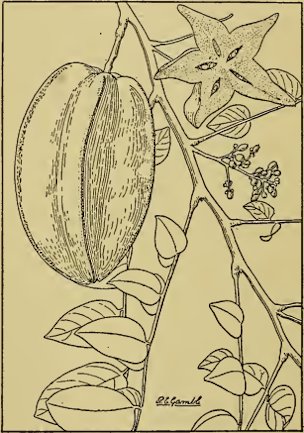From the Manual Of Tropical And Subtropical Fruits
by Wilson Popenoe
The Carambola
Averrhoa carambola L.
"There is another fruit called Carambola," wrote the Dutch traveler
Linschoten in 1598, "which hath 8 corners, as bigge as a smal aple,
sower in eating, like unripe plums, and most used to make Con-serues."
The Chinese and the Hindus eat the carambola when green as a vegetable,
when ripe as a dessert. It is widely distributed in the tropics, but in
America it is not so highly esteemed as in the Orient.
The tree
is small, handsome, and grows up to 30 feet in height. It has compound
leaves composed of two to five pairs of ovate or ovate-lanceolate
leaflets, rounded at the base and acute to acuminate at the apex, 1 1/2
to 3 inches long, glabrous, light green above and glaucous below. The
small white or purplish flowers are borne in short racemes from the
bark of the young and old branches. The petals are five; the stamens
ten, but five are without anthers. The fruit is oval or elliptic in
outline, translucent yellow or pale golden brown in color, 3 to 5
inches long, and three-, four-, or five-ribbed longitudinally, so that
a cross-section is star-shaped. "It contains a clear watery pulp,"
writes W. E. Safford, "astringent when green and tasting like sorrel or
green gooseberries, but pleasantly acid when ripe, or even sweet, with
an agreeable fruity flavor, and a strong perfume like that of the
quince"

Fig. 55. A flowering and fruiting branch of carambola (Averrhoa Carambola), an Asiatic fruit sometimes cultivated in tropical America. (X 1/2)
While
the native home of this species is not definitely known, it is believed
to be indigenous to the Malayan region, whence it was early brought to
America. It is now cultivated in southern China, and from there
westward to India. Safford states that it grows in Guam, but is not
common. It also grows in the Philippines and in Hawaii. In America it
is most abundant in Brazil, where it was doubtless introduced by the
Portuguese. It does not grow in California, but succeeds in southern
Florida. E. N. Reasoner has a handsome specimen in his tropical fruit
shed at Oneco, near Bradentown, a place which would be too cold for the
species were it not given some protection during the winter. It is rare
on the lower east coast of Florida.
The name carambola is said
to have come from Malabar, and was early adopted by the Portuguese. In
upper India the fruit is called kamranga or kamrakh. The presence of a
Sanskrit name, karmara, and the accounts of early writers, indicate
that the plant was known in India before the time of European
colonization. The Chinese are said to call the fruit yongt'o or foreign
peach. In the Philippines it is termed balimbing as well as carambola;
in Guam bilimbines.
The fruits, when fully ripe, are eaten out
of hand, or they may be stewed. When slightly unripe they are used for
jelly and pickles. Like the bilimbi, the carambola contains potassium
oxalate, and for this reason the unripe fruit is used in dyeing and to
remove iron-rust. In southern China carambolas are preserved in tin
and exported to other countries. An analysis made in Hawaii by Alice R.
Thompson shows the ripe fruit of the sweet variety to contain: Total
solids 8.22 per cent, ash 0.42, acids 0.78, protein 0.71, total sugars
3.40, fat 0.75, and fiber 1.23.
In its climatic requirements the
tree may be considered tropical. It withstands very little frost and
when young is injured by temperatures above the freezing-point. It
prefers a warm moist climate and a deep rich soil, but it can be grown
successfully on sandy soils and heavy clays, and in northern India it
thrives where the climate is dry. Cold is the limiting factor in
California and Florida; in the latter state it may succeed from Palm
Beach southwards, but plants have often failed to grow at Miami. When
young the carambola is delicate and requires careful attention.
Safford
states that the tree is long-lived and a constant bearer, producing, in
Guam, several crops a year. Father Tavares writes of its behavior in
Brazil: "During the entire year it loads itself with successive crops
of flowers and fruits, except for a short period when it is devoid of
foliage."
Propagation is readily effected by means of seeds, and
P. J. Wester has shown that budding is successful. He states that
budwood should be beyond the tender stage, but not so old that it is
brittle. It should not be used if the petioles have fallen. The buds
should be cut an inch in length, and inserted in inverted T-incisions,
the operation of budding being essentially the same as with the avocado.
No horticultural varieties of the carambola are yet established. Sweet and sour seedling forms are sometimes recognized.
Back to
Carambola Page
|
|